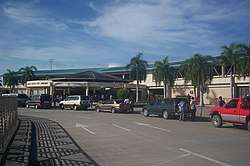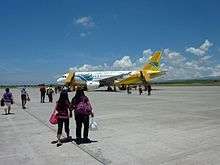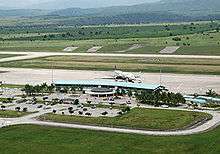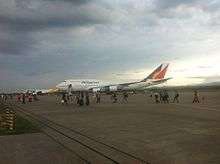General Santos International Airport
General Santos International Airport, (stylized as General Santos City Airport) (Cebuano: Tugpahanang Pangkalibutanon sa Heneral Santos, Hiligaynon: Pangkalibutan nga Hulugpaan sang Heneral Santos), (IATA: GES, ICAO: RPMR) is an alternate international airport located in the city of General Santos, Philippines serving the greater area of SOCCSKSARGEN (Region XII). Situated in Prk New Hondagua, Uhaw, Barangay Fatima, it is the largest airport in the island of Mindanao[2] and is officially classified an International Airport by the Civil Aviation Authority of the Philippines (CAAP), a government bureau which is responsible for the management and operations of General Santos International Airport and all other airports in the country except regular international airports.
General Santos International Airport Tugpahanang Pangkalibutanon sa Heneral Santos (Cebuano) Pangkalibutan nga Hulugpaan sang Heneral Santos (Hiligaynon) | |||||||||||
|---|---|---|---|---|---|---|---|---|---|---|---|
 Terminal building of General Santos International Airport. | |||||||||||
| Summary | |||||||||||
| Airport type | Public | ||||||||||
| Operator | Civil Aviation Authority of the Philippines | ||||||||||
| Serves | General Santos | ||||||||||
| Location | Filipino-American Friendship Avenue. Uhaw, Brgy. Fatima, General Santos, Philippines | ||||||||||
| Elevation AMSL | 154 m / 505 ft | ||||||||||
| Coordinates | 06°03′28″N 125°05′45″E | ||||||||||
| Website | generalsantos-airport | ||||||||||
| Map | |||||||||||
.svg.png) GES/RPMR Location in the Philippines | |||||||||||
| Runways | |||||||||||
| |||||||||||
| Statistics (2018) | |||||||||||
| |||||||||||
The airport was inaugurated on July 6, 1996, in time to serve the influx of visitors, athletes, and participants coming in from different parts of the Philippines who were taking part in the 42nd annual Palarong Pambansa (National Games) that was held in South Cotabato, Sarangani and General Santos (SOCSARGEN) area at that time. The new airport immediately replaced the old and smaller Buayan Airport in Barangay Buayan, which has been converted into an air station for the Philippine Air Force and renamed "Rajah Buayan Air Base". Though new, wider and much more modern, General Santos International Airport nevertheless retained its old IATA airport code (GES) from the old Buayan Airport.
History
In 1993, the airport, which, at the time, would be the largest airport in Mindanao, was built mainly on a fund granted by the United States Government amounting to USD 47.6 million[2] through its United States Agency for International Development (USAID). The Philippine Government, through the Department of Transportation and Communication (DOTC), has co-shared 25% of the total project cost of the airport.[3] It is strategically situated on a 5,994,577-square-meter (599.4577 hectares)[4] plot of high-altitude, government-owned and formerly leased pasture land in Barangay Fatima approximately 14 kilometers away from the central business district of General Santos. It was rumored that the construction of the airport was part of a forward strategy of the US Military forces in the Philippine Islands in an, accordingly, apparent attempt to reestablish their presence in Southeast Asia.[5][6][7] This allegation came out a few years later after the Americans' eviction from their installations at Subic Naval Base, Olongapo and Clark Air Base, Pampanga in 1992.[8] Both the U.S. and the Philippine governments denied the allegation.[9]
Upon the opening of the new airport in 1996, it has since gotten hold of the record as the biggest airport facility in the island of Mindanao, which has then become a very promising addition to the potential of the city in its bid to become a "Boom Town"—which means rapidly developing urban center—as it was indeed dubbed as is during the time. All flights, in small aircraft, to and from Iloilo and Cebu cities by the national flag carrier Philippine Airlines (PAL) that were previously operating in the old and smaller Buayan Airport has since then landed and departed in this new and far better airport facility. On the first few weeks of operation of the new airport, PAL has initially deployed its Boeing 737-300 aircraft to serve its special direct flights to and from the capital to serve the travel needs for the ongoing Palarong Pambansa sports event being held during the time. As before there were no direct flights going to and from the capital of Manila to General Santos as PAL could not utilize its wider body and long range aircraft to safely land and take off in the city's old and smaller Buayan Airport. During then, there were only two options for air travelers to get to Manila by air from General Santos and vice versa. One, is to take and wait for a connecting flight to Manila upon arrival in Mactan–Cebu International Airport in Cebu, and second, is to take a tiresome and lengthy 4-hour land travel by land to Davao City's airport to catch a direct flight to Manila and vice versa.
Philippine Airlines commenced regular thrice weekly direct flights to and from Manila using a bigger and wider Airbus A300-B4 aircraft. Later, this became five times weekly in November 1996. And four months after its launch, a daily service was in effect in December 1997 while maintaining its existing regular frequencies to and from Iloilo and Cebu cities using smaller Fokker 50 aircraft. The airline's initiative to commence a direct flight to and from the capital has helped pave the way to continually increase not only the air passenger traffic that are coming in and out of city's very own airport but as well as air cargo traffic which is indicative of the city's vibrant tuna export industry and fast growing economy in general. However, PAL's financial difficulties in the late 90s forced the halting of its Iloilo and Cebu routes out of General Santos International Airport in 1998, leaving PAL with only its single daily frequency to and from Manila to operate in the airport. In 1997, Air Philippines (now Airphil Express) commenced its daily Manila–General Santos–Manila flight using Boeing 737-200 and McDonnell Douglas MD-88 aircraft.
The first international chartered flight to land in General Santos International Airport was of former President Fidel V. Ramos' homecoming from one of his state visits abroad in the mid 90s. Aboard PAL's Airbus A340 aircraft, the president and his party landed in General Santos International Airport directly from Bangkok. In November 2003, international flights to and from Manado, Indonesia were also briefly operational on a regular weekly frequency to this city by an Indonesian carrier Merpati Nusantara Airlines[10] using Fokker 70 aircraft. PAL has also disclosed plans of commencing international flights to and from General Santos City in the late 90s.
Cebu Pacific, the Philippines' largest low-cost carrier, commenced daily flights to and from Manila on October 2, 2006, initially deploying Airbus A319 aircraft. This was later upgraded to Airbus A320, Airbus A330 and is being used up till the present time.

Having a runway length of 3,227 meters and a runway width of 45 meters,[11] General Santos International Airport has the country's third longest runway—to date—after Ninoy Aquino International Airport in Manila and Mactan–Cebu International Airport in Cebu. It is the first airport in Mindanao to have accommodated the landing and take off of Boeing 747 aircraft. The airport is also capable of handling landings and take-offs of even larger aircraft such as Airbus A380.
With the 48-hour shutdown of Davao International Airport on June 2–3, 2013 due to an accident involving a Cebu Pacific aircraft from Manila, General Santos International Airport handled most of the diverted flights from Davao for the stranded passengers going to and coming from Manila, Cebu, Zamboanga and Kalibo cities.[12][13]
Bigger aircraft such as Boeing 777-300ER, Airbus A340 and Airbus A330 come to the airport due to tuna cargo and increase of passengers, leaving the airport as the only domestic destination of the Philippine Airlines besides PAL Express.
Airlines and destinations

As of June 8, 2020, some flights have resumed, with particular schedules of operations mandated by the City Mayor. However, due to cancellation of flights because of the COVID-19 pandemic, this list is no longer current and destinations are subject to change without prior notice.[14][15]
| Airlines | Destinations |
|---|---|
| Cebu Pacific | Cebu, Iloilo, Manila |
| Leading Edge | Clark, Zamboanga |
| Philippine Airlines | Manila |
| Philippine Airlines operated by PAL Express | Cebu, Davao,[16] Iloilo |
| Philippines AirAsia | Cebu, Clark, Manila |
Ever since the COVID-19 pandemic, Airbus A330s of Cebu Pacific regularly land at the airport to deliver medical supplies and essential cargo as some of which have been temporarily converted into freighters. A few visits of the airline’s A330s were also scheduled passenger flights. The aircraft was deployed for high-density operations, especially because social distancing is enforced inside the aircraft during this pandemic.[17]
Structure
Runway


General Santos International Airport has a single 3,227-meter lighted runway designated as runways 17/35.[11] Made entirely of reinforced concrete and macadam, the airport's runway is the third-longest runway in the Philippines, after Runway 06/24 of Ninoy Aquino International Airport and Runway 04/22 of Mactan-Cebu International Airport respectively and it can access Airbus A380.
Access and transportation
General Santos International Airport is approximately 14 kilometers away from the central business district of General Santos. A concrete 6-kilometer Philippine-American Friendship Road and the 30-kilometer General Santos Diversion Road connects the airport to the Pan Philippine Highway leading to the city proper as well as to the nearby provinces.
Statistics
Passenger traffic
| Year | Passenger
movements |
% Change from
Previous Year |
|---|---|---|
| 2001 | 148,204 | |
| 2002 | 129,945 | |
| 2003 | 186,870 | |
| 2004 | 151,048 | |
| 2005 | 181,306 | |
| 2006 | 208,367 | |
| 2007 | 310,233 | |
| 2008 | 302,887 | |
| 2009 | 404,859 | |
| 2010 | 477,535 | |
| 2011 | 492,572 | |
| 2012 | 611,274 | |
| 2013 | 688,673 | |
| 2014 | 714,523 | |
| 2015 | 592,911 | |
| 2016 | 838,941 | |
Future
Expansion
The Department of Transportation and Communication (DOTC) will begin the preparatory works for the P959-million expansion project for the international airport. Noel Quiratman, secretary of the Regional Development Council (RDC) of Region 12, said such development was relayed to the council by the DOTC, which had adopted the project as among its priorities this year. The RDC-12 and other local stakeholders made a strong push last year for the implementation of the project that was funded by the national government under the 2015 budget. The official said the project covers the rehabilitation and expansion of the airport’s terminal building and other component facilities. He said the arrival and departure area of the terminal building, which has not undergone any major repair since it opened in 1996, will be expanded to cope with the airport's growing passenger traffic.[18]
Facelift
The proposed General Santos International Airport passenger terminal building that will double its capacity to accommodate future operations that will go hand in hand to the rapid economic growth of the General Santos City. The facade design of the airport is patterned after the fins of the yellow-fin tuna. The consideration of the existing second floor of the terminal building which is ideal for the terminal building to expand vertically and for the boarding bridges. About PhP400 million is for the air-side development such as the apron and avionics while about PhP450 million is for the land side development which will cost about PhP255 million — this covers the renovation and expansion of the existing structure which includes the following areas: Pre-Departure, Baggage Build-up, Escalator Lounge, Main Hall, Public Concourse, Boarding Bridge, and Greeters' Lounge.[19]
Accidents and Incidents
- Flights to and from Francisco Bangoy International Airport were diverted to General Santos International Airport on June 2, 2013 after a Cebu Pacific Flight 971 (registration number RP-C3266) carrying 165 passengers inbound from Manila, overshot the runway at Francisco Bangoy International Airport during a heavy rain. There were no fatalities, however the plane was heavily damaged that resulted to airport closure for two days.
See also
References
- Civil Aviation Authority of the Philippines - Aerodrome Development & Management Service (15 April 2018). "Passenger Statistics Philippines". Republic of the Philippines - Freedom of Information Portal. Retrieved 27 April 2019.
- "Manila Standard - Google News Archive Search". News.google.com.
- News, Philippine Information Agency, retrieved August 5, 2010
- News, Independent Catholic. "Bishop fears return of US bases to Philippines | ICN". Indcatholicnews.com.
- "Archived copy". Philippine Daily Inquirer. Archived from the original on 2012-03-26. Retrieved 2011-05-05.CS1 maint: archived copy as title (link)
- "Sun Journal - Google News Archive Search". News.google.com.
- "Archived copy". Archived from the original on 2012-03-28. Retrieved 2011-09-27.CS1 maint: archived copy as title (link)
- Airport Information, Civil Aviation Authority of the Philippines, retrieved August 5, 2010
- "TwitLonger — When you talk too much for Twitter". Twitlonger.com.
- "Davao economy bleeds P5M a day as airport shutdown cripples trade". GMA News. GMA Network.
- "Corona Virus Disease 2019 (COVID-19)". www.philippineairlines.com. Retrieved 2020-08-02.
- hkvalidate.perfdrive.com https://hkvalidate.perfdrive.com/cebu/captcha?ssa=4eb744df-277a-4bc8-a9c6-589a5a46b06c&ssb=k4dkm40p46hge5iahc604zbff&ssc=https%3A%2F%2Fwww.cebupacificair.com%2Fpages%2Ftravel-advisories&ssd=050296736307065&sse=c@c@fghhencheij&ssf=811e7a5a8b0e12cc16c843861a7012a1844d446d&ssg=f70c023d-7874-47fb-b20a-d91dee0c5b05&ssh=5e754945-bff9-4321-979b-00d050e87f7d&ssi=b6f1d327-9f13-4a5d-ad56-efeec58c9264&ssj=6496e04f-3f66-4c19-8840-7e4b783e08d1&ssk=support@shieldsquare.com&ssl=178297301766&ssm=33650570808614215105552906926156&ssn=f609fad3b26f0e63eb9c7c8c209865a820779bba2add-a34e-43c4-9641e6&sso=09f09026-f3a639e7fc7b0f089f493c8974d7d2f2604e75b38a1d0eb6&ssp=59180936211596399513159630871732453&ssq=89185046924463598754569244633559089241446&ssr=MjA4LjgwLjE1My42MQ==&sss=Chrome/5.0%20(iPhone;%20U;%20CPU%20iPhone%20OS%203_0%20like%20Mac%20OS%20X;%20en-us)%20AppleWebKit/528.18%20(KHTML,%20like%20Gecko)%20Version/4.0%20Mobile/7A341%20Safari/528.16&sst=ZoteroTranslationServer/WMF%20(mailto:services@lists.wikimedia.org)&ssu=Mozilla/4.0%20(Windows%20NT%205.1)%20AppleWebKit/535.7%20(KHTML,like%20zeco)%20Chrome/33.0.1750.154%20Safari/536.7&ssv=q432oq@u1u@2@rm&ssw=&ssx=939217425946027&ssy=fmlnnlhhbagoepnaadgkj@dgdgbb@nlcaephaenp&ssz=23e0e8efe9d2f48. Retrieved 2020-08-02. Missing or empty
|title=(help) - https://news.abs-cbn.com/ancx/culture/spotlight/05/19/20/pal-flights-to-and-from-manila-cebu-and-clark-are-cancelled-until-may-31here-are-your-options
- "Cebu Pacific to deploy 436-seat Airbus A330 to General Santos - Aviation Updates Philippines | Latest Philippine aviation news". www.auphilippines.com. Retrieved 2020-07-25.
- "P959M expansion project for GenSan airport to start this month". MindaNews. January 15, 2015.
- "Gensan Airport To Get A Major Facelift". Gandaeversomuch.com. March 1, 2015.
External links
| Wikimedia Commons has media related to General Santos International Airport. |
- Airport information for RPMR (current airport in Brgy. Fatima) at World Aero Data. Data current as of October 2006.Source: DAFIF.
- Airport information for RPMR (current airport in Brgy. Fatima) at Great Circle Mapper. Source: DAFIF (effective October 2006).
- Accident history for GES/RPMB (former airport in Brgy. Buayan) at Aviation Safety Network